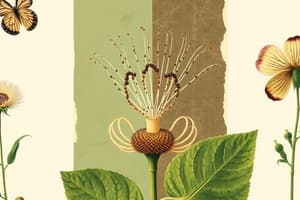Podcast
Questions and Answers
Which type of pollination occurs between different plants of the same species?
Which type of pollination occurs between different plants of the same species?
- Autogamy
- Self-pollination
- Cleistogamous
- Cross-pollination (correct)
Cleistogamous flowers promote cross-pollination.
Cleistogamous flowers promote cross-pollination.
False (B)
What is the main advantage of cross-pollination?
What is the main advantage of cross-pollination?
Promotes genetic diversity and adaptability.
Pollen grains are transferred from the anther to the stigma of the same flower in _______.
Pollen grains are transferred from the anther to the stigma of the same flower in _______.
Which of the following adaptations is NOT commonly found in flowering plants to attract pollinators?
Which of the following adaptations is NOT commonly found in flowering plants to attract pollinators?
Match the types of pollination with their descriptions:
Match the types of pollination with their descriptions:
Self-pollination ensures genetic diversity among plant populations.
Self-pollination ensures genetic diversity among plant populations.
What is a key disadvantage of self-pollination?
What is a key disadvantage of self-pollination?
What term describes cross-pollination between flowers on different plants?
What term describes cross-pollination between flowers on different plants?
Dioecious plants have both male and female reproductive organs on the same plant.
Dioecious plants have both male and female reproductive organs on the same plant.
What is the genetic mechanism that prevents self-pollination called?
What is the genetic mechanism that prevents self-pollination called?
The positioning of the anther and stigma can prevent self-pollination by being at different __________.
The positioning of the anther and stigma can prevent self-pollination by being at different __________.
Which of the following describes plants that produce unisexual flowers?
Which of the following describes plants that produce unisexual flowers?
Match the terms with their definitions:
Match the terms with their definitions:
Self-incompatibility allows pollen to germinate even if it is incompatible with the stigma.
Self-incompatibility allows pollen to germinate even if it is incompatible with the stigma.
What prevents self-pollination by ensuring that pollen from a male plant must reach a female plant?
What prevents self-pollination by ensuring that pollen from a male plant must reach a female plant?
Which of the following is NOT a biotic pollinator?
Which of the following is NOT a biotic pollinator?
Geitonogamy involves the transfer of pollen between different flowers on the same plant.
Geitonogamy involves the transfer of pollen between different flowers on the same plant.
What is the primary advantage of self-pollination?
What is the primary advantage of self-pollination?
Water pollination is also known as _______.
Water pollination is also known as _______.
Match the following types of pollination with their characteristics:
Match the following types of pollination with their characteristics:
What is the main characteristic of flowers that are pollinated by wind?
What is the main characteristic of flowers that are pollinated by wind?
Xenogamy involves pollen transfer to the stigma of the same flower.
Xenogamy involves pollen transfer to the stigma of the same flower.
Name an example of a plant that uses epihydrophily.
Name an example of a plant that uses epihydrophily.
The process by which pollen is transferred from the anther to the stigma is known as _______.
The process by which pollen is transferred from the anther to the stigma is known as _______.
Match the following types of pollinators with their categories:
Match the following types of pollinators with their categories:
Which of the following is a disadvantage of self-pollination?
Which of the following is a disadvantage of self-pollination?
Pollinators often receive rewards from flowers in the form of nectar.
Pollinators often receive rewards from flowers in the form of nectar.
What type of pollination does chiropterophily refer to?
What type of pollination does chiropterophily refer to?
Most flowering plants rely on ________ pollination.
Most flowering plants rely on ________ pollination.
Flashcards
Pollination
Pollination
The transfer of pollen grains from the anther (male part) to the stigma (female part) of a flower.
Self-pollination
Self-pollination
Pollination occurring within the same flower or between flowers of the same plant.
Autogamy
Autogamy
Pollen grains transferred from the anther to the stigma of the same flower.
Geitonogamy
Geitonogamy
Signup and view all the flashcards
Cross-pollination
Cross-pollination
Signup and view all the flashcards
Xenogamy
Xenogamy
Signup and view all the flashcards
Chasmogamous flowers
Chasmogamous flowers
Signup and view all the flashcards
Cleistogamous flowers
Cleistogamous flowers
Signup and view all the flashcards
Self-incompatibility
Self-incompatibility
Signup and view all the flashcards
Monoecious
Monoecious
Signup and view all the flashcards
Dioecious
Dioecious
Signup and view all the flashcards
Inbreeding depression
Inbreeding depression
Signup and view all the flashcards
Yucca Moth-Yucca Relationship
Yucca Moth-Yucca Relationship
Signup and view all the flashcards
Pollinators
Pollinators
Signup and view all the flashcards
Wind pollination
Wind pollination
Signup and view all the flashcards
Water pollination
Water pollination
Signup and view all the flashcards
Abiotic pollination
Abiotic pollination
Signup and view all the flashcards
Biotic pollination
Biotic pollination
Signup and view all the flashcards
Entomophily
Entomophily
Signup and view all the flashcards
Ornithophily
Ornithophily
Signup and view all the flashcards
Chiropterophily
Chiropterophily
Signup and view all the flashcards
Outbreeding devices
Outbreeding devices
Signup and view all the flashcards
Mutualism
Mutualism
Signup and view all the flashcards
Study Notes
Pollination
- Pollination is the transfer of pollen grains from the anther, the male reproductive part of a flower, to the stigma, the female reproductive part of the flower.
- Pollination is essential for flowering plants, enabling fertilization of the egg cell (female gamete) by the sperm cell (male gamete).
- External agents, or pollinators, are necessary for this process.
Types of Pollination
-
Self-pollination occurs within the same flower or between flowers on the same plant.
- Autogamy: Pollen transfer between the anther and stigma of the same flower.
- Geitonogamy: Pollen transfer between the anther and stigma of different flowers on the same plant.
-
Cross-pollination involves different plants of the same species.
- Xenogamy: Pollen transfer between the anther and stigma of different plants.
Characteristics of Flowers Based on Pollination Mechanisms
- Chasmogamous flowers: Open flowers with exposed anthers and stigmas, enabling cross-pollination.
- Cleistogamous flowers: Closed flowers, promoting self-pollination (autogamy).
Advantages and Disadvantages of Self and Cross Pollination
-
Self-pollination:
- Advantages: Ensures pollination even without pollinators, beneficial in isolated areas or with limited pollinators.
- Disadvantages: Reduced genetic diversity, leading to decreased adaptability and disease resistance.
-
Cross-pollination:
- Advantages: Increased genetic diversity, promoting adaptability and healthier, more resilient offspring.
- Disadvantages: Dependent on pollinators, which can be vulnerable to habitat loss or climate change.
Key Adaptations in Flowering Plants for Pollination
- Flowers have adaptations to attract pollinators and improve pollination success.
- Brightly colored petals attract visual attention.
- Nectar production provides a food source.
- Fragrance attracts pollinators via scent.
- Flower structure facilitates pollen transfer.
Pollinators: The Agents of Reproduction
- Pollinators are organisms transferring pollen from anther to stigma.
- Examples: Bees, butterflies, moths, birds, wind, water, insects.
- Wind pollination (anemophily): Common in plants with small, open flowers producing abundant light, small pollen.
- Water pollination (hydrophily): Rare in flowering plants, usually in aquatic plants.
Self-pollination vs. Cross-pollination
- Self-pollination is between a single flower or different flowers on the same plant.
- Cross-pollination is between flowers on different plants.
- Autogamy, geitonogamy, xenogamy are specific types of self and cross-pollination.
Pollinators and their categories
- Pollinators transfer pollen.
- Abiotic pollinators are non-living:
- Wind (anemophily)
- Water (hydrophily).
- Biotic pollinators are living organisms:
- Insects, butterflies, moths (entomo),
- Birds(ornithophily),
- Bats (chiropterophily),
- Other animals (zoophily).
Wind Pollination
- Wind pollination (anemophily) is common.
- Wind-pollinated plants produce huge quantities of lightweight, non-sticky pollen.
- Exposed stamens facilitate pollen release.
- Feathery stigmas increase pollen capture.
Water Pollination
- Water pollination (hydrophily) is rare in flowering plants.
- Limited to about 30 genera, mainly in aquatic monocots.
- Epihydrophily: Pollination at the water surface.
- Hypohydrophily: Pollination below the water surface.
- Examples: Vallisneria (epi), Zostera (hypo).
- Most algae and bryophytes use water for gamete transport.
Biotic Pollination
- Most plants rely on animals for pollination.
- Bees are prominent biotic pollinators.
- Large animals can also be pollinators for some species.
- Flowers adapted to animals are often large, colorful, fragrant, and have nectar.
Outbreeding Devices
- Most flowers are hermaphrodites (both sexes).
- Self-pollination is possible but can lead to inbreeding depression.
- Adaptations to avoid self-pollination:
- Asynchronous pollen release and stigma receptiveness.
- Anther and stigma positioning preventing self-contact.
- Self-incompatibility preventing fertilization if pollen and stigma are incompatible.
Mutualism
- Flowers reward pollinators with nectar and pollen.
- Pollinators brush against reproductive parts, transferring pollen during reward collection.
- Some flowers provide insect egg-laying sites.
- Mutualistic relationship exists between Yucca and a moth species.
Preventing Self-Pollination
- Mechanisms to prevent same-flower self-pollination:
- Timing of pollen release and stigma receptiveness differs.
- Anther and stigma positioning differ (preventing contact).
- Self-incompatibility prevents fertilization with the same pollen.
- Unisexual flowers (e.g., monoecious and dioecious) further prevent self-pollination.
Key Terms
- Autogamy: Self-pollination within the same flower.
- Geitonogamy: Self-pollination between different flowers on the same plant.
- Xenogamy: Cross-pollination between different plants.
- Inbreeding depression: Reduced fitness in offspring due to mating between closely related individuals.
- Monoecious: Having male and female reproductive organs in separate flowers on the same plant.
- Dioecious: Having male and female reproductive organs on separate plants.
- Self-incompatibility: A genetic mechanism preventing self-pollination.
Studying That Suits You
Use AI to generate personalized quizzes and flashcards to suit your learning preferences.





